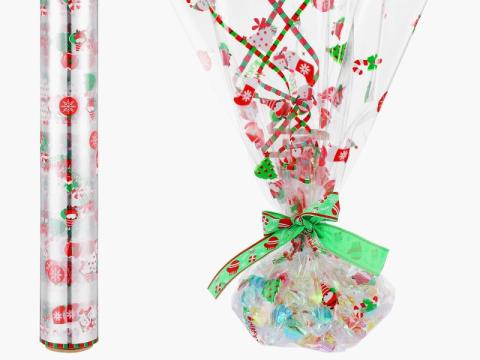Cellophane, also known as transparent paper, is a semi-transparent film material obtained from cellulose by a high degree of chemical treatment. Its main raw material comes from wood pulp or other plant fibers and is made through special manufacturing processes such as alkali treatment, bleaching, dissolving and then shaping. Because of its glass-like transparency and gloss, it is named "cellophane". It is a renewable and environmentally friendly material and is biodegradable under certain conditions.
Features
- High transparency: cellophane is transparent and colorless, the visual effect is close to that of glass, which can clearly display the items inside the package and increase the display effect of goods.
- Good breathability: The unique micro-permeability of cellophane allows gases (mainly oxygen and carbon dioxide) to pass through moderately, which is particularly suitable for certain commodities that need respiration to maintain freshness, such as fruits and vegetables.
- Excellent barrier properties: Despite its breathability, cellophane has good barrier properties to moisture, grease, and other contaminants, preventing external microbial invasion and internal moisture evaporation, thus extending the shelf life of the product.
- Physical and chemical stability: it has the characteristics of heat-resistant, frost-resistant, anti-aging, anti-oxidation, etc. It can maintain stability in a wide range of temperatures, which is suitable for packaging needs under various climatic conditions.
- Environmental protection and safety: cellophane is non-toxic, odorless, harmless to human body, easy to recycle after disposal, in line with the modern concept of green environmental protection.
- Variety: According to different processing methods and added components, cellophane can be divided into moisture-resistant and non-moisture-resistant types, such as PT film and PC film, etc., adapting to the packaging requirements of different scenarios.
Applications
- Food industry: It is widely used in the packaging of all kinds of food, including but not limited to confectionery, bakery products, cooked food, meat, fruits, and vegetables, etc., which helps to maintain the freshness and taste of food.
- pharmaceutical industry: in the pharmaceutical field, cellophane can be used for drug packaging, both to protect the drug from external influences, but also to ensure that it maintains its efficacy for a certain period.
- Cosmetics and personal care products industry: used for masks, skin care products, perfume, and other products packaging, not only to show the beauty, but also help to ensure product quality.
- Tobacco products packaging: cellophane is often used in high-end cigarettes and other products outside the package, providing good protection and perception.
- Industrial packaging: cellophane can also be used as the inner packaging material for certain metal parts or precision instruments that need to be rust-proof, moisture-proof and corrosion-proof.
Product Category





